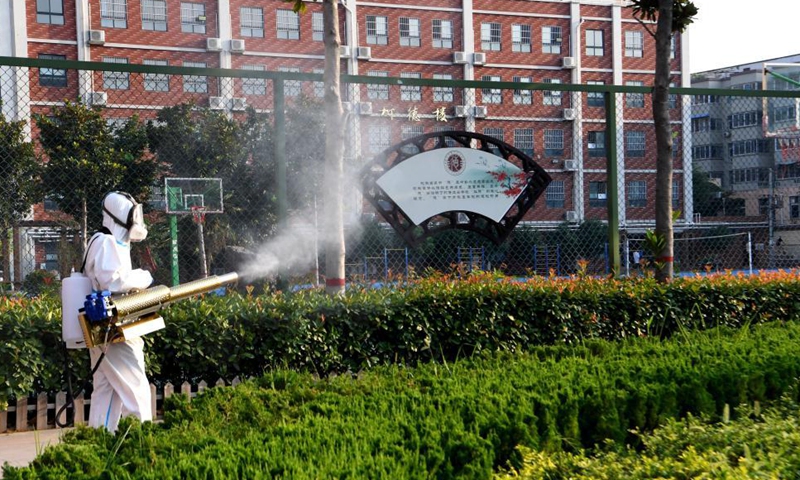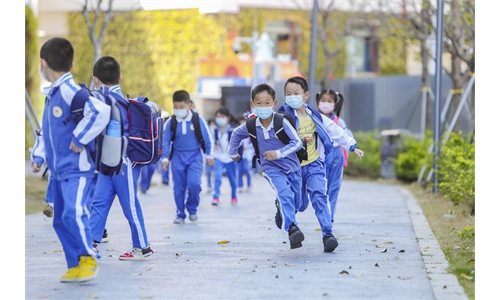
A rescue worker sprays disinfectant at the No. 22 Middle School in Xinxiang, central China's Henan Province, July 25, 2021. Disinfection works are underway in schools, hospitals, garbage transfer stations and some other areas in the flood-hit city of Xinxiang. Photo: Xinhua
Several cities in China, including Wuhan, Central China's Hubei Province, and the capital city Beijing, have determined school start dates or announced online class arrangements amid local COVID-19 clusters that have spread at least 19 provinces and regions in China.
Wuhan authorities said on Saturday that kindergarten and primary and junior high schools in the city will officially open on September 1, becoming the second city that has determined opening dates for the three stages of education. Beijing made a similar announcement on Wednesday.
Education officials in Zhengzhou, capital of Central China's Henan Province, which is recovering from record flooding, said the city will provide online registration and instruction for the upcoming semester starting on September 1. The city has a total of 138 confirmed cases and one silent carrier in the recent outbreak of COVID-19.
Colleges and universities across the country are also setting the opening dates for in-person or online classes, mostly at the end of August or the beginning of September. Students will be strictly checked with their "health code" when they register and return to school.
Wuhan University pushed back the registration date for new students from August 19 to September 2, and it postponed military training for freshmen to July 2022, Li Qin, deputy minister of the Student Affairs Department of Wuhan University, told the Global Times on Sunday.
He said the specific school policies of epidemic prevention and control for newcomers and returning students are under review, and arrangements may be further adjusted according to the local epidemic situation.
Authorities in Southwest China's Yunnan Province and East China's Shandong Province urged teachers and students in low-infection risk areas outside the province to return as soon as possible, and required them to go through 14-day quarantine before school starts.
Although more and more places are preparing for the fall semester, the cities hit hard by the epidemic remain cautious on opening the school gates to large groups.
Nanjing in Jiangsu Province, where this new round of outbreaks in China started, and Zhangjiajie, a key spot of infections during the latest spike, said over the weekend that they had suspended the starting dates for primary and junior high schools and kindergartens, which by convention should fall on September 1, with the specific arrangement due to be determined.
A Nanjing government official said at a Sunday press conference that students will return to school in batches after 21 days, when all areas of the city have turned to low-risk status.
Though the epidemic situation in China is still unstable, cities should resume schools in accord with their local epidemic situation, which is also one part of the nation's normalization of epidemic prevention and control, Wang Peiyu, a deputy head of Peking University's School of Public Health, told the Global Times on Sunday.
China's Ministry of Education announced on August 9 that schools have to first meet local epidemic control requirements before being allowed to open for the fall semester.
More than 1,200 COVID-19 cases have been reported in China's latest outbreaks since July 20, which has spread to at least 19 provinces and regions as of Sunday.
He Qinghua, an official of the National Health Commission, said at a press conference on Friday that the nationwide epidemic situation is generally under control, and the risk of a large-scale outbreak at the national level is relatively small.

